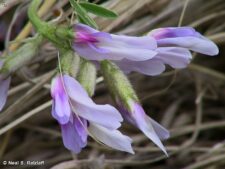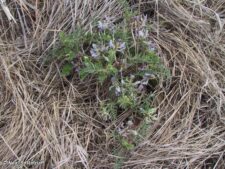
This native perennial, with several branching, sprawling stems forms circular 1-3 foot diameter clumps of green among the mostly brown prairie foliage of very early spring (C). The alternate, pinnately compound leaves have 7-13 pairs of opposite leaflets plus one at the tip (A,C). Clusters of 5-25 elongated pea-like flowers up to 1 inch in length, varying from white to shades of pink and purple, are borne at the end of the flower stalk (A,B). They are replaced by characteristic clusters of plump, rounded, green, plum-sized fruits which turn purple as they mature. The heavy fruits settle to the ground looking like purple eggs in a nest, hence the name “ground plum.”
Grows in drier upland prairie sites, flowering from late April to early June. At Neale Woods, it is rare (two plants have been seen) in the Jonas Prairie restoration to the left of Gifford Trail about 100 feet beyond the bench.
The new fruits of ground plum are edible and were an important food source for Native Americans and early settlers who ate them raw or cooked. Caution is advised since many wild legumes, including members of this genus which are often called locoweeds, are poisonous and should never be eaten without positive identification. Crassicarpus, a word with Greek and Latin roots, means “thick pod” aptly describing the fruit. The two plants at Neale Woods have flowered but never produced fruit, hence no photos of the characteristic fruits responsible for both the common and scientific names are available.
Other common names include, Buffalo Pea, Prairie Apple and Indian Pea.
The content of NatureSearch is provided by dedicated volunteer Naturalists of Fontenelle Forest who strive to provide the most accurate information available. Contributors of the images retain their copyrights. The point of contact for this page is: Neal Ratzlaff.


